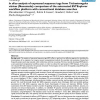Free Online Productivity Tools
i2Speak
i2Symbol
i2OCR
iTex2Img
iWeb2Print
iWeb2Shot
i2Type
iPdf2Split
iPdf2Merge
i2Bopomofo
i2Arabic
i2Style
i2Image
i2PDF
iLatex2Rtf
Sci2ools
BMCBI
2008
2008
In silico analysis of expressed sequence tags from Trichostrongylus vitrinus (Nematoda): comparison of the automated ESTExplorer
Background: The analysis of expressed sequence tags (EST) offers a rapid and cost effective approach to elucidate the transcriptome of an organism, but requires several computational methods for assembly and annotation. Researchers frequently analyse each step manually, which is laborious and time consuming. We have recently developed ESTExplorer, a semi-automated computational workflow system, in order to achieve the rapid analysis of EST datasets. In this study, we evaluated EST data analysis for the parasitic nematode Trichostrongylus vitrinus (order Strongylida) using ESTExplorer, compared with database matching alone. Results: We functionally annotated 1776 ESTs obtained via suppressive-subtractive hybridisation from T. vitrinus, an important parasitic trichostrongylid of small ruminants. Cluster and comparative genomic analyses of the transcripts using ESTExplorer indicated that 290 (41%) sequences had homologues in Caenorhabditis elegans, 329 (42%) in parasitic nematodes, 202 (...
| Added | 24 Dec 2010 |
| Updated | 24 Dec 2010 |
| Type | Journal |
| Year | 2008 |
| Where | BMCBI |
| Authors | Shivashankar H. Nagaraj, Robin B. Gasser, Alasdair J. Nisbet, Shoba Ranganathan |
Comments (0)

